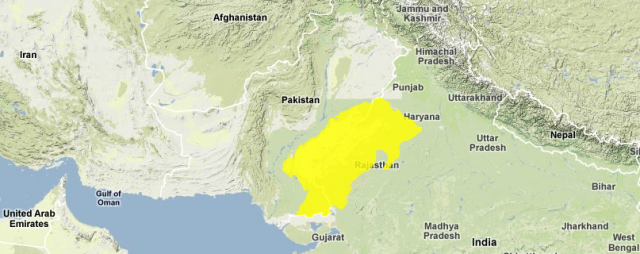Thar Desert
THE THAR DESERT, often called the Indian Desert, extends for about 400 mi (644 km) from southwest to northeast and has a maximum width of about 225 mi (362 km). The desert is limited to the south by the Great Rann of Cutch. To the west lies the valley-plain of the INDUS RIVER and to the northwest that of the Sutlej. Northwestward the desert fades into the Punjab state of INDIA, and the Aravalli range marks the southern limit. The greater part of the desert lies in the Indian state of Rajasthan, of which it occupies nearly half. The remainder is in PAKISTAN, where the desert occupies a large part of the former princely state of Bahawalpur and the old province of Sindh.
The greater part of the desert surface is composed of sands, silts, and loesslike material, the finer-grained making excellent soil where water is available. The name Thar (desert or sandy waste) refers to the sand hills accumulated by the prevailing winds. Saline dust is transported from the Indus delta and the Rann of Cutch and deposited in hillocks. In the southwest, long ridges (in local Sindhi language, bhits) are found aligned from southwest to northeast parallel to the prevailing winds. In the northeast, these give place to transverse dunes of barchan type, though they are somewhat irregular. Toward the Rann, dunes more or less permanent may rise to 200 ft (76 m) above the general sandy surface; inland they are smaller.

The average rainfall in the area is 15 in (38.1 cm) a year and on the western margins near the Indus this drops to less than 5 in (12.7 cm). Temperature varies from 55 degree F (13 degrees C) to -70 degree F (-21 degrees C) in the cold season and from 90 degrees F (32 degrees C) up to 127 degrees F (53 degree C) in the warm season. Dust storms are common at the periods of reversal of pressure, about April to May and during October.
Surface deposits everywhere are impregnated with salt derived from the evaporation of subsoil brine and the accumulation of salt particles blown from the Rann. On the eastern margins of the desert are the Rajasthan salt lakes. Lake Sambhar, the largest, lies in a closed depression in the Aravalli schists with a surface at 1,184 ft (361 m).